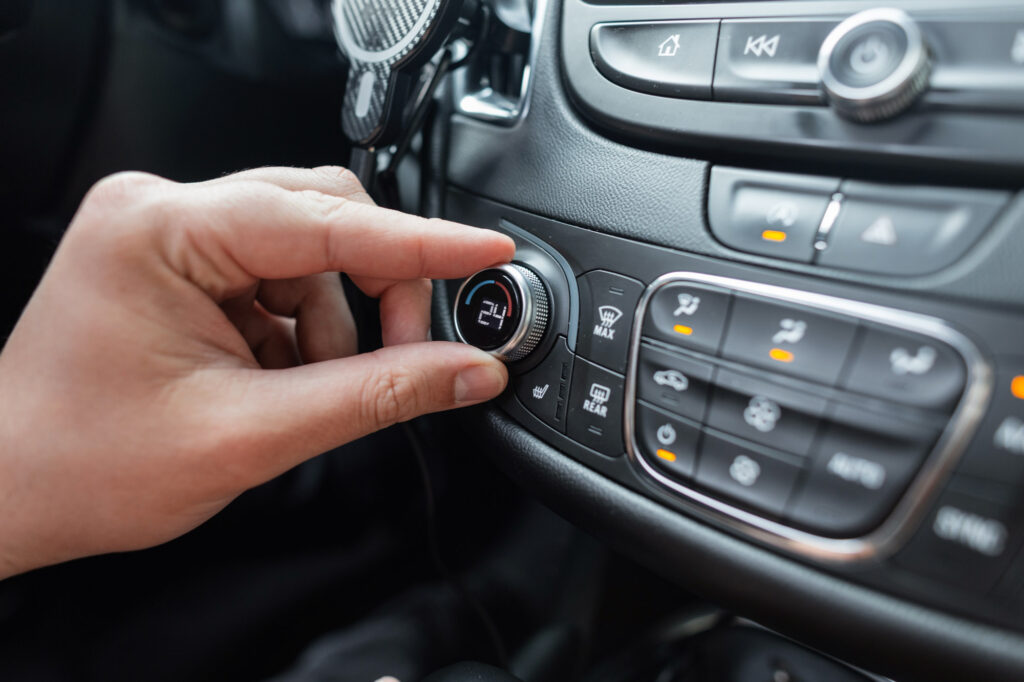Did you know that touchscreen technology has been around since the mid-60s?
It started when Eric Arthur Johnson invented the first finger-driven touchscreen for traffic control in 1965. Various sectors took up and developed the tech. In the automotive world, the first car to have a touchscreen feature rolled out in the mid-80s.
While it’s a seemingly clear advancement in car technology, some automakers have been dialing back on touch screens and bringing back physical buttons.
The Rise of Touchscreens in Modern Vehicles
Before discussing the rise of touchscreen technology in vehicles, it’s best to look back at how and when it started. Believe it or not, the first iteration of touch screens in a car was the 1986 Buick Riviera.
Buick referred to this feature as the “Graphic Control Center,” and had the following functions:
- Automatic Climate Control: Allowed drivers to set and maintain the desired cabin temperature.
- AM/FM Radio: With an optional graphic equalizer for better sound quality.
- Trip Computer: Calculated and displayed trip information such as distance traveled, fuel economy, and estimated time of arrival.
- Gauges: Displayed various vehicle gauges like speed, fuel level, and engine temperature.
Vehicle Diagnostics: Provided information on the status of the powertrain, electrical system, brakes, and other vehicle data.
Of course, touchscreens didn’t take off until later on. Part of the reason is because they were resistive, meaning they relied on pressure to generate a response. The technology back then also had limited accuracy, registering only one input at a time.
It wasn’t until 26 years after the Riviera was launched that Tesla paved the way for vehicle touchscreen technology with the introduction of the Model S. It features a 17″ touchscreen display that offers a 2200 x 1300 resolution, true colors, and responsiveness for gaming, movies, and more.
Model S’s touchscreen feature lets users control the interior air vents, dim the lights, navigate, and more. It’s arguable that Model S started the vehicle touchscreen trend we see today. Newer models feature touchscreens integrated with advanced features, similar to Teslas, including GPS navigation, backup cameras, and gesture control.
Disadvantages of Touchscreen Controls
Of course, while advancements in technology are something to behold, touchscreen interfaces are not without drawbacks. Some drivers consider them to be too distracting, complex, and unresponsive. Plus, if the touchscreen stops working, some of the functions they hold can become inaccessible.
Distracting
Interacting with touchscreens requires you to directly look at the screen and take your eyes off the road. Unlike physical buttons, you can’t rely on feel to operate touchscreens.
This lack of tactile feedback can be detrimental. For example, according to a 2020 study by independent UK road safety nonprofit IAM RoadSmart, choosing a song on Spotify caused drivers to take their eyes off the road for up to 20 seconds. That’s more than enough time to get cut off and cause accidents.
Complex
Touchscreens are naturally complex, with some functions buried behind piles of menus, making them harder to access. It’s time-consuming and potentially frustrating, especially if you’re doing simple tasks like adjusting fan speed or directing airflow.
Unresponsive
On top of the already complex design of touchscreens, they can be unresponsive because of the old technology they use. One reason is manufacturers tend to outsource infotainment screens instead of making their own. While this lowers production costs, the touchscreen controls aren’t always up-to-date with the latest tech.
Risk of Failure
One disadvantage of streamlined controls is when something malfunctions, there’s a chance most of the operation is compromised. Once a touchscreen fails, it can render some functions inaccessible, unlike physical buttons with individual circuits.
And while screens don’t typically break, it can happen as time passes by because of the accumulated wear.
The Return of Physical Buttons
Complaints about the downsides of touchscreen controls in vehicles didn’t fall on deaf ears. Volkswagen, one of the premier auto manufacturers, decided to backtrack on going buttonless, starting with the new ID. 2all concept.
The concept introduces physical, backlit buttons below the touchscreen to provide access to HVAC controls. This is due to customer feedback, especially in Europe, where consumers have asked for more physical buttons. The ID. 2all is expected to make its debut in Europe around 2025.
Advantages of Physical Buttons

For the most part, most of us are used to having physical buttons inside our cars because they’ve been around longer. Some advantages of reverting to buttons include having tactile feedback, better efficiency, improved reliability, ease of use (in some conditions), and reduced visual distraction.
Tactile Feedback
One of the biggest advantages of having physical buttons over touchscreens is tactile feedback. Physical buttons reduce the risk of distracted driving since they provide surety and can add levels of familiarity.
You don’t have to take your eyes off the road to double-check your turning on a feature because the button’s shape and feel are confirmation enough. It’s similar to how people can text on keypad phones or change channels using a remote without looking.
Simplicity and Efficiency
As mentioned, touchscreens have an innate problem wherein certain features are behind piles of menus. However, with physical buttons, most functions have separate buttons for you to control.
Whether it’s the radio, thermostat, or navigation, you’ll likely find the button you need without digging through different menus. This is useful because you can familiarize yourself with the placement of the buttons, reducing the risks of distraction.
Reliability
While they’re prone to damage, physical buttons aren’t affected by software glitches and unresponsive screens like touchscreens are. This means they’re much more reliable, and you won’t have to worry about program-related malfunctions.
However, this can be to their detriment as well. When some buttons malfunction, they can affect the entire system.
Ease of Use in Certain Conditions
Touchscreens can be sensitive and difficult to operate under certain circumstances. For example, wearing thick gloves during winter may prevent you from operating the screen because some are made with non-conductive material.
This will never be an issue with physical buttons, as you can push or dial them with or without gloves.
Less Visual Distraction
The tactile feedback and the lack of a screen means there’s less chance of distraction. As mentioned, physical buttons are easy to operate because you can get used to the physical placement and what they do.
Less visual distraction also means lower odds of getting into accidents caused by neglecting the road.
The Future of Car Interiors
The future of car interiors is still up in the air. We’ve seen the rise and fall of touchscreen infotainment in the last decade. It’s difficult to predict what the trends will be in a couple of years. However, the signs point to a vehicle interior that combines a touchscreen and physical buttons.
Volkswagen’s ID. 2all concept is proof of this. Its infotainment system will still have the touchscreen features introduced by the Tesla while having a row of reliable and easy-to-access buttons beneath.
Any information provided on this Website is for informational purposes only and is not intended to replace consultation with a professional mechanic. The accuracy and timeliness of the information may change from the time of publication.























